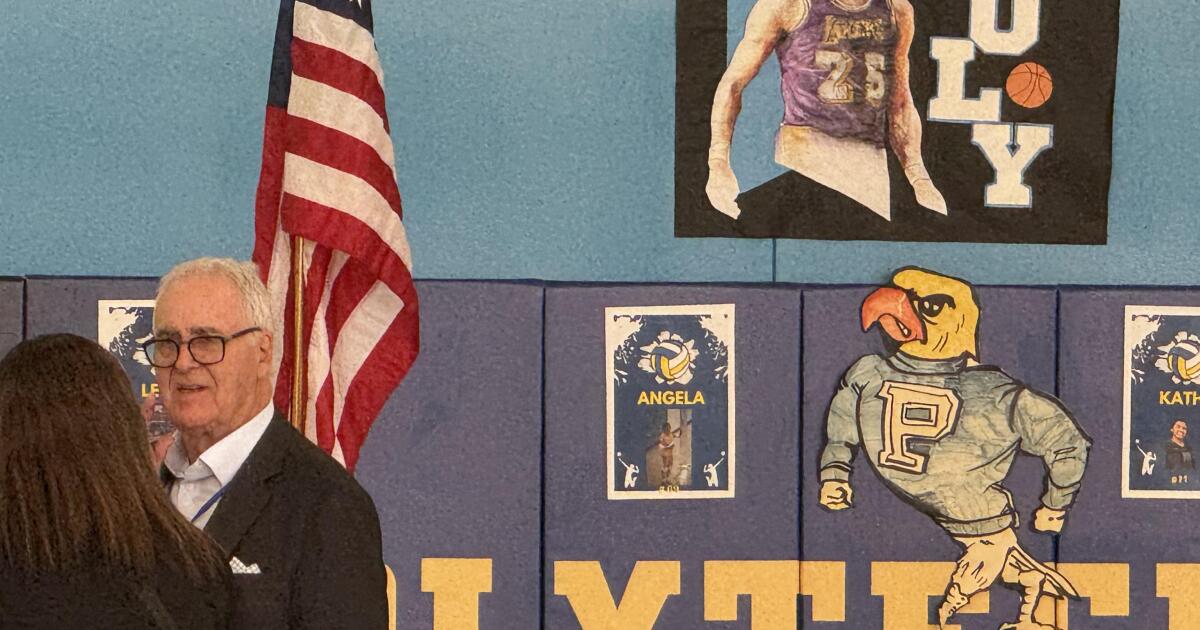Gail Goodrich honored with alma mater naming its gym for him
“Los Angeles sports legend” is the most appropriate way to describe the contributions of Gail Goodrich, who returned to Southern California on Friday as an 82-year-old full of stamina and humbleness after his alma mater, Sun Valley Poly High, named its gymnasium the Gail Goodrich Sports Complex.
“This is where it all started,” Goodrich said. “I have great memories here. I’m emotional that they’re going to name the gym after me. I had great coaches. I had great teammates. I’ve been one to always look to the future. Today is a day to recall and look back.”
There are few individuals in sports history who achieved what he accomplished in his hometown as a basketball standout. He led Poly to the City championship over Manual Arts in 1961, helped UCLA win two NCAA titles under coach John Wooden, including a record-setting 42-point performance in the 1965 final, and won an NBA title as the Lakers’ leading scorer in 1971-72 on a team that had a 33-game winning streak and featured fellow future Hall of Famers Jerry West and Wilt Chamberlain.
In the 1961 title game, Goodrich suffered an ankle injury in the third quarter. He came back to dominate the fourth quarter, finishing with 29 points. He played the game on a Wednesday, graduated on a Friday and was at UCLA that Monday.
Four of Goodrich’s high school teammates attended Friday’s ceremony, including center Ernie Brandt, who said, “I’m the guy who passed the ball to him all the time.”
This was the second gym-naming ceremony for Goodrich, who traveled from his home in Idaho in 2015 to see Madison Middle School in North Hollywood name its gym the Gail Goodrich Sports Center.
He graduated from Madison at 5 feet 2 and 99 pounds. At Poly, by his senior year, he was nearing 6 feet tall. He was known for his accurate left-handed shooting touch. He recalled how his father built a basket at home and he practiced into the night.
“I lived at the Poly gym. I became a gym rat. The gym became my second home,” he said.
He helped launch Wooden’s UCLA basketball dynasty that would lead to 10 titles in 12 years. Assistant coach Jerry Norman was one of the few recruiters to pay attention to him in high school and was at Poly on Friday. Goodrich was inducted into the Naismith Memorial Basketball Hall of Fame in 1996.
In 2014, Goodrich wrote about Wooden, “He never talked about winning. He talked about being a success and being able to look in the mirror at the end of the day. If you did the very best you could, that’s all anybody could ask.”
Poly opened its gym two seasons ago. Officials sought recommendations for dedicating the gym. Poly coach Joe Wyatt said there was no need for debate.
“I said, ‘Gail Goodrich.’ That’s an easy one. That’s perfect,” Wyatt said.
“As a friend told me, ‘I reached the top of the mountain for my craft,’” Goodrich told Poly students who filled up the bleachers. “Yes, you will get roadblocks and get knocked down. Sometimes you have to take three steps back, but find your mountain and don’t let anyone tell you you can’t do it.”
